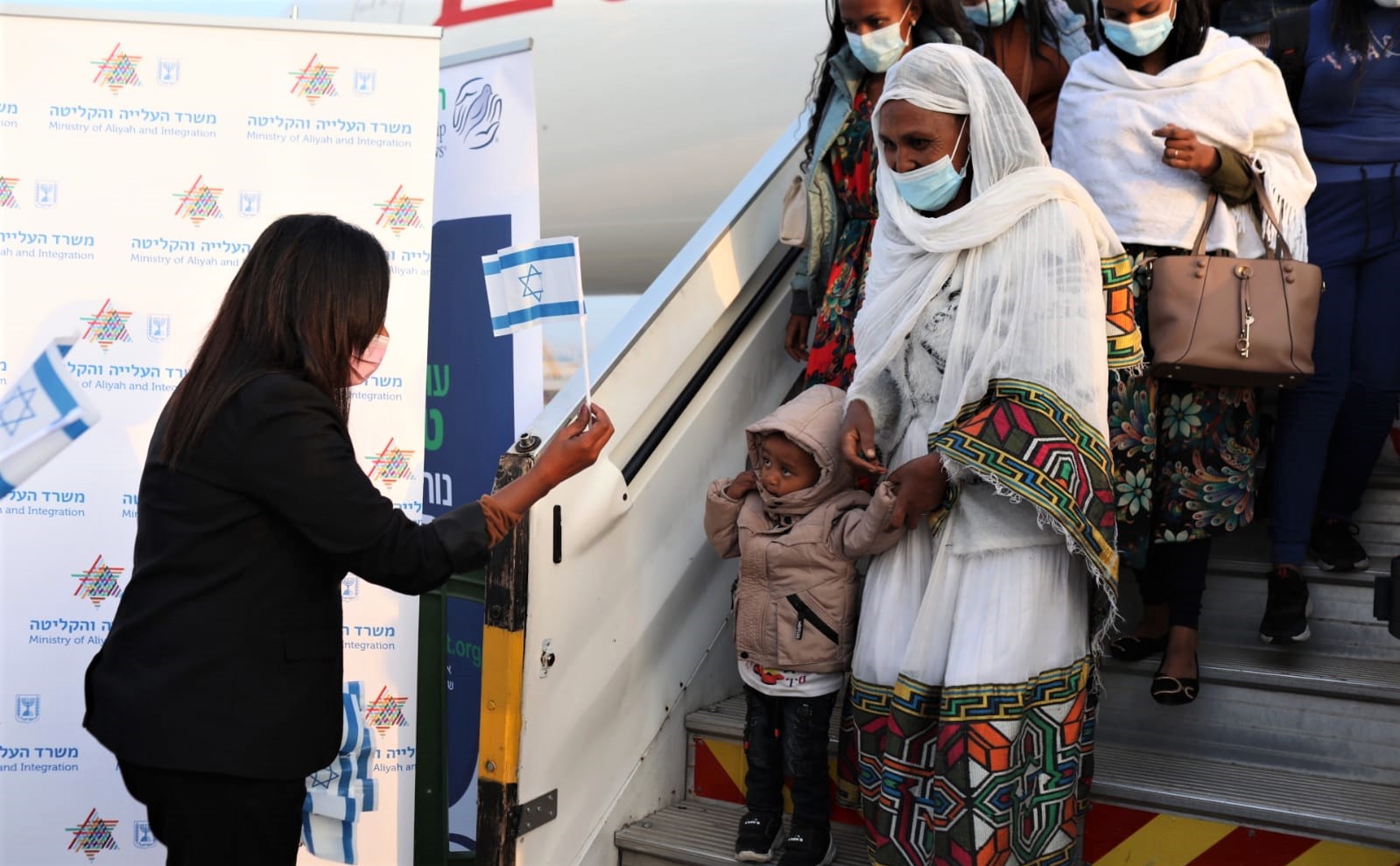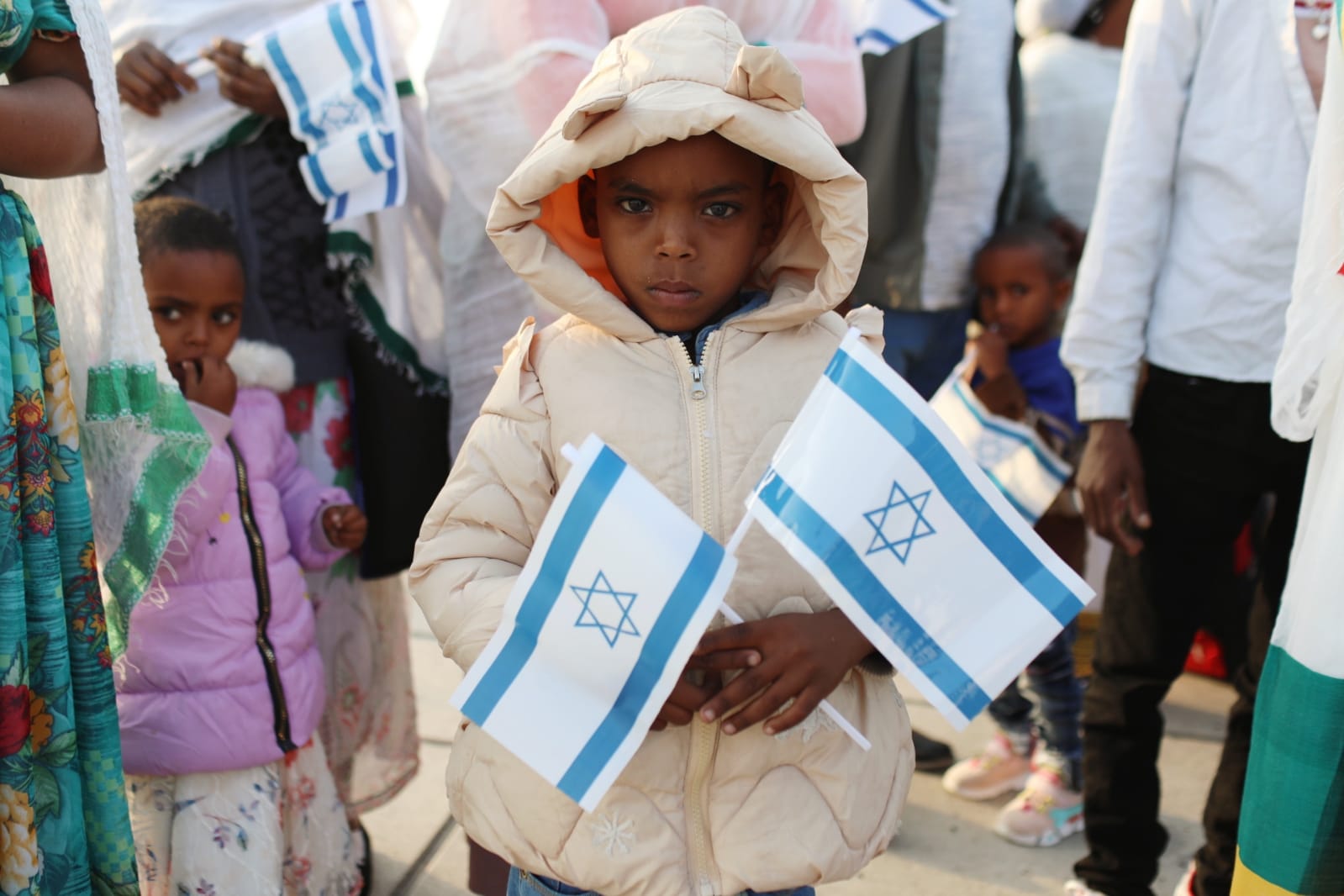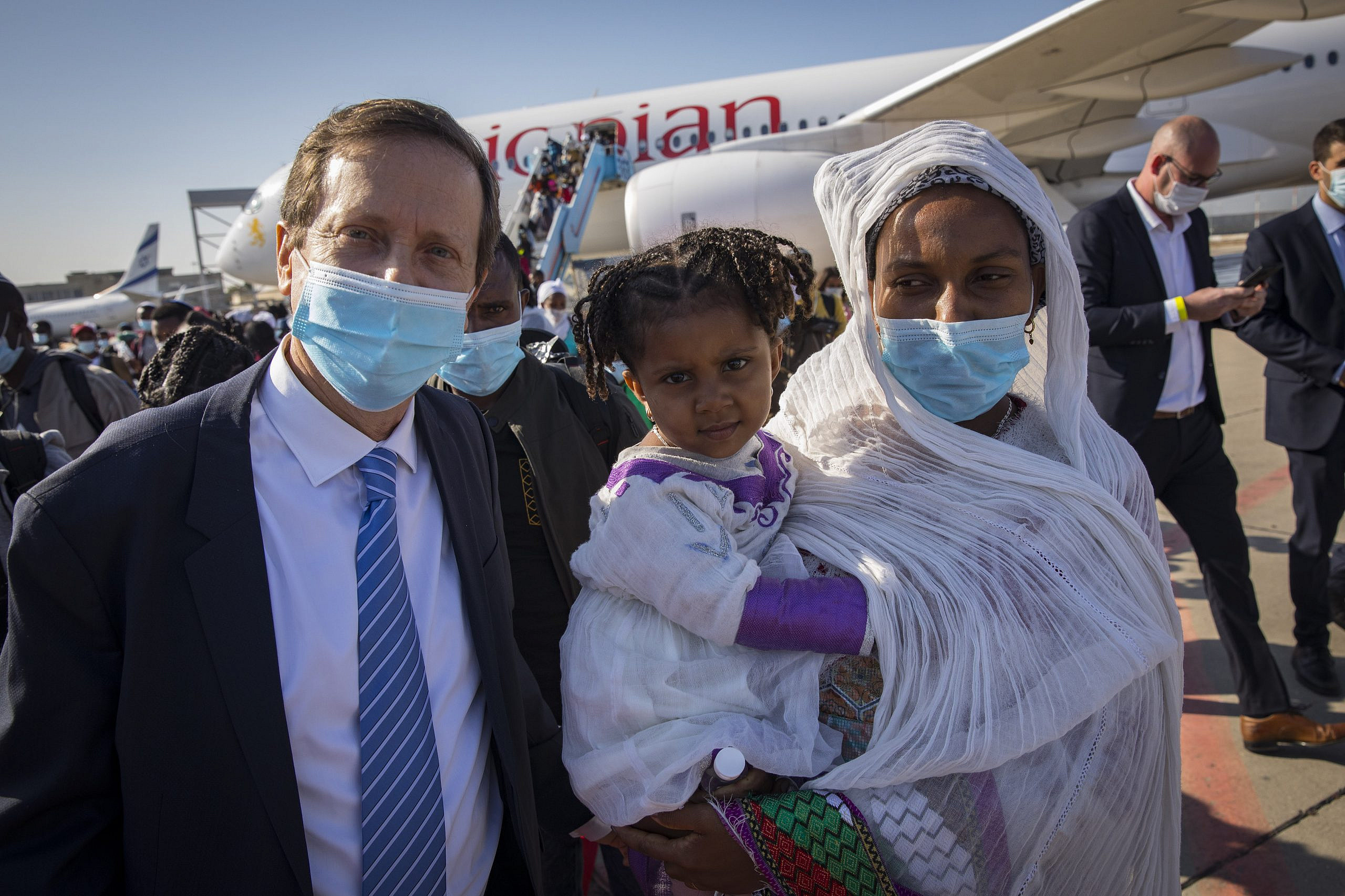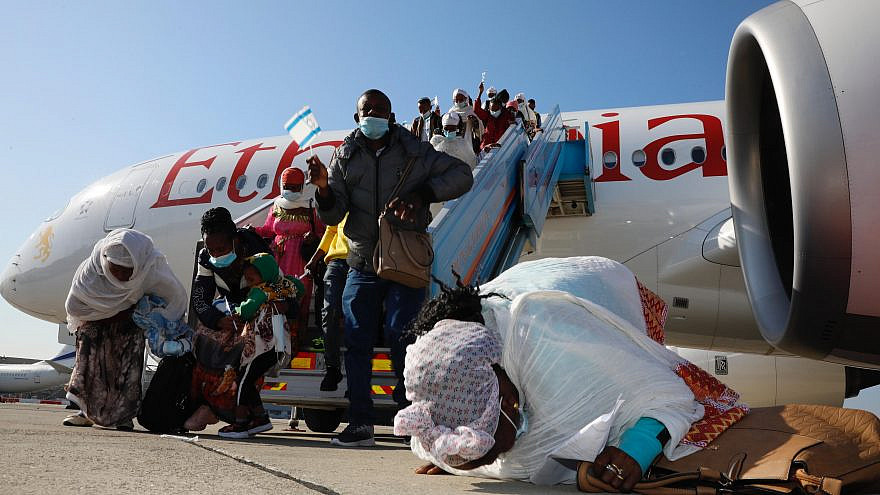Experts in global Jewish history believe that highlighting minority voices within the Jewish community has the power to honor its nuances and interconnectedness. JNS’s new series highlighting Jewish ethnic minorities aims to elevate their voices, and in turn, celebrate the beautiful mosaic that is the Jewish people.
A total of 930 new Ethiopian olim landed in Israel in 2020, most immigrating as a part of family reunification initiative “Operation Tzur Israel” (“Operation Rock of Israel”). The immigrants fled malnutrition, poverty, extreme conditions and a tense security situation in Ethiopia—aggravated by the coronavirus pandemic—to fulfill a 2,000-year-old old dream of arriving to the land of Israel and to Jerusalem.
The flights, coordinated by the Jewish Agency for Israel, Israel’s Ministry of Aliyah and Integration, and Israel’s Ministry of Interior, followed the Government of Israel’s decision in October to approve the immigration of 2,000 members of the Ethiopian community, many of whom were left behind after “Operation Solomon” and have been waiting for decades to move to Israel and reunite with their families.
Bringing the immigrants home, said Minister of Aliyah and Integration Pnina Tamano-Shata, is correcting a “horrendous and immoral mistake” by the State of Israel, which “instead of bringing a family—an entire family unit—families were separated, parents from children, grandfathers and grandmothers.”
Since the establishment of modern-day Israel in 1948, the government has brought 95,000 immigrants from Ethiopia. In the mid-1980s, 8,000 immigrants arrived with “Operation Moses” through Sudan. As part of “Operation Solomon” conducted in 1991, an airlift brought 14,000 immigrants to Israel. In the summer of 2013, the Jewish Agency concluded “Operation Doves Wings,” which brought 7,000 immigrants from Ethiopia to Israel.
Today, approximately 13,000 Jews currently reside in Addis Ababa, the Ethiopian capital, and in Gondar in the northern part of the African country. According to the Jewish Agency, most live in poverty and are waiting to be taken to Israel, which they consider their homeland.
“My goal is to hasten this aliyah, eventually leading to the closing of the camps in Gondar and in Addis Ababa,” Tamano-Shata told JNS.

The minister, who immigrated to Israel from Ethiopia as a 3-year-old with “Operation Moses,” declared the 2020 operation “one of the greatest deeds and one of the best decisions made by the unity government … a moment that transcends the controversies and debates, a moment of saving lives, and most importantly, a moment of national duty that reminds us who we are as a people, and that we are privileged to return home after thousands of years of exile.”
A drawn-out process
Compared to other immigrant populations of Israel, the Ethiopian community’s immigration has been one of the most drawn out, partially because diverse groups exist within Ethiopia’s Jewish community. Many also believe that there have been economic and religious-based pressures that have kept the government of Israel from bringing the remaining Ethiopians to Israel.
Some 8,000 Falash Mura (a Jewish Ethiopian community whose ancestors converted to Christianity under pressure in the early 1900s) are waiting to make aliyah from Ethiopia with their immigration previously approved in 2015 by a government decision.
But just as soon as their immigration was again approved in 2018, reports surfaced in the Jewish press claiming that because the Falash Mura “remain faithful to Christianity and do not adhere to Jewish law,” they should not be eligible to immigrate under Israel’s Law of Return, which dictates that any individual with one grandparent Jewish may make aliyah with a spouse and children as long as that individual “is not part of another religion.”
“My goal is to hasten this aliyah, eventually leading to the closing of the camps in Gondar and in Addis Ababa,” said Minister of Aliyah and Integration Pnina Tamano-Shata.
Most Israelis consider these allegations to be ignorant and outright false.
“There is no question that they are Jewish by law and practice,” said Aaron (A.Y.) Katsof, director of the Heart of Israel, an organization that is working with the Binyamin Fund to raise money to resettle these Ethiopian Jews in the biblical heartland. “There was very little intermarriage among the Falash Mura,” Katsof, who travels to Addis Ababa and Gondar on a monthly basis to report on their extreme poverty and living conditions, previously told JNS.
“Almost all of them go to shul, go to the mikvah, keep Shabbat—eating cold food and sometimes losing their jobs because they do not work on Shabbat. Most have not touched meat or chicken in nine years, as there is no kosher meat available there,” he said, while “observant Jews in Israel and the U.S. have trouble not eating meat for just nine days during the month of Av.”
According to Katsof, when the Falash Mura immigrate, most continue as Torah-observant Jews and send their children to religious schools at a rate higher than the rest of the Israeli Jewish population. The Falash Mura, he argued, are not accepted because of a mix of racist, financial and political excuses.
“How can people say they are not Jews?” he pondered. “The Falash Mura are more Jewish than many of us are.”
Tamano-Shata explained that in regard to the new immigrants who came with “Operation Tzur Israel,” many of these families were perceived as if “they decided to leave Beta Israel, the Jewish community, that decision applied extreme pressure on the community. Meanwhile, it needs to be known that in fact, most of them did not strike roots with others and are Jewish from their fathers. This is why there was a delay.”

Tamano-Shata added that in addition to the misconceptions about their status as Jews, Israel was guided by economic considerations that has stalled their immigration. “I believe that it is time to look at these people in the eye and not through an economic prism which is what was done for many years,” she said. “On my part, as a member of this community, I will help stop their suffering and do everything to lead to an end to this humane and painful saga.”
“It is very difficult for people to understand that the Ethiopian community are descendants of Avraham, Isaac and Yaakov,” said Rabbi Dr. Sharon Shalom, an Orthodox rabbi and captain in the Israel Defense Forces’ Reserves. “My friend at Princeton, Professor Ephraim Isaac, who is Yemenite and Ethiopian, once gave a speech about Ethiopian Jews, and many were in shock. An Ashkenazi Jew from Poland questioned the connection between Jews and Ethiopia, so Ephraim said to take the Bible and look for the word Ethiopia. At least 50 times, Ethiopia appears in the Bible. Now, he said, look for the world Poland. None. But the question isn’t about if there is any connection between Poland and Jews.”
According to Shalom, Ethiopian Jews descend from the 10 tribes of Israel. “Halachically and historically, there is no doubt in our Jewishness,” he said.
Shalom expressed his challenges with hypocrisy to his being an Ethiopian Orthodox rabbi. When he suggested in his book, From Sinai to Ethiopia, that Ethiopian Jews should be allowed to continue their Jewish traditions and heritage, “immediately, I became a heretic [among haredi circles]. From their perspective, I was not authentic, but here I was talking to an Ashkenazi Jew wearing a shtreimel—the shtreimel came from Poland! It rose from the culture of Polish people, not Jews. Polish Jews adopted this tradition,” he said.
“They put me on the blacklist,” he quipped. “How can you put an Ethiopian rabbi on the blacklist?”
Preparing for aliyah
According to Shay Felber, director general of the Jewish Agency Integration and Aliyah Unit, the absorption of Ethiopian Jews begins even before they arrive, as “the Jewish Agency staff meets with the olim regularly and prepares them for the entire process—from the paperwork, to medical checkups, to the quarantine and then absorption. They learn about life in Israel, the absorption centers, the education system, employment prospects and what happens during their first year. A special team of volunteers is also set to travel to Ethiopia to work with the youth through a variety of informal educational programs aimed at preparing them for life in Israel.”
Once in Israel, Felber told JNS, they are transported to an absorption center, where staff there speak Amharic and are familiar with the culture. “All staff involved with absorption undergo special training to ensure they are sensitive to the needs of the olim. While the staff at the absorption centers teach the new olim about life in Israel, they also take measures to ensure their existing traditions are preserved,” he said.
“In addition to providing them with items like winter clothing and radiators for the cold weather, there is also a sensitivity to the food supplies provided—making sure to first begin with familiar foods like fruits, vegetables and legumes. Residents of the absorption centers welcome new arrivals with homemade injera and other Ethiopian foods.”

A challenging absorption in Israel
All immigrants find some level of difficulty integrating into the Israeli culture and systems; however, Ethiopians often experience even greater challenges because of the disparities between culture, language and, some believe, because of their skin color.
“I believe that the specific challenge of Ethiopian Jews is firstly the disparities between the two countries. I remember when we made aliyah to Israel in the 1980s, the challenges were much larger. Today, I think that olim that arrive are much more prepared, and yet, there are still gaps between the two countries that we have to bridge. We must remember that many of them arrive from villages,” related Tamano-Shata.
“I can say that the challenge of the difference in skin color also poses a struggle with racism and discrimination; this is an issue that I’ve been dealing with for many years,” she added.
The topic of racism within Israeli society has been prevalent for decades, though came to a head last year following the shooting of a young Israeli-Ethiopian man by an off-duty police officer. The violence of the riots, along with accusations that Israel’s police and government are racist, surprised many across Israel, raising concerns that organizations with political agendas were inflaming the protests for political gain.
While most are quick to call any parallels between racism in Israel versus the United States “absurd,” when Ethiopian immigrants do arrive in Israel, continued the minister, they struggle with poverty, as they are “paved to specific cities and neighborhoods in these cities,” which Tamano-Shata said is detrimental to their absorption into Israeli society and equal opportunity to succeed.
Moreover, she said, “the data shows that Ethiopian Jews are objectively living in higher rates of poverty and are subject to additional challenges. To my regret, this includes suicide rates; the rate of those committing suicide is higher.
“Halachically and historically, there is no doubt in our Jewishness,” said Rabbi Dr. Sharon Shalom, an Orthodox rabbi and captain in the Israel Defense Forces’ Reserves.
Though Shalom acknowledges that he doesn’t know why there is such misunderstanding and discrimination when it comes to Ethiopian Jews, he emphasized, “the roots are not around racism.”
He further stressed that the challenges that Ethiopians face in Israel are significantly different than the challenges they would face in the United States, and their main struggle is not because of the color of their skin but because of misperceptions of who is Jewish.
“Here in Israel, the question isn’t around racism,” he declared, calling the equating the experience of black people in Israel to black people in America “very superficial.”
“You cannot compare the tension and challenges of Ethiopian Jews as what exists in America. In the States, the issue is racism,” he said, adding that within Israeli society, there is at present a 12 percent intermarriage rate between Ashkenazi and Ethiopian Jews (of course, it wasn’t that way in prior decades), whereas in the United States there is just a 6 percent intermarriage rate.
There is widespread awareness that Ethiopian Jews who immigrate to Israel are in need of larger comprehensive government support compared to other olim. “The different local authorities and the state bodies do everything in order to ease their landing into Israeli society. Even after they leave the absorption centers, of course, it doesn’t end,” said Tamano-Shata. “The local authorities receive support for absorption. They are accompanied, there are professionals who work in the local authorities on all matters to assist them, even with education, welfare and the comprehensive support that they need.”
“In Israel, there’s a different education system, family structures change in Israel, and the economic situation is different. We take all this into consideration when preparing the olim so they can more easily adjust to life in Israel,” added Felber.
One major breakthrough has been in the military. Ethiopian Jews, like the rest of the population, serve in the IDF, with many having risen to leadership positions, including Shalom.
According to Isaac Herzog, chairman of the Jewish Agency, it accompanied the new olim on their journey—from pre-aliyah preparations in Ethiopia to the absorption centers spread throughout Israel—and will continue for two years to assist in their integration into Israeli society, including Hebrew learning and preparing for the Israeli education system and workforce.
In Ethiopia, alongside preparing the olim for life in Israel and flying them to Israel, the Jewish Agency continues to operate in the humanitarian field among the community waiting in Ethiopia, including medical care and daily nutrition programs for children and pregnant or nursing women.
The future of Ethiopian Jewry
Tamano-Shata and Shalom are but two examples of many Ethiopian Israelis succeeding within society.
Hundreds of programs exist in Israel to improve the lot of Ethiopian Jews. The minister, for one, has led a program of urban renewal in impoverished neighborhoods where members of the community live to enable young couples to receive subsidized mortgages, subsidized after-school activities and supervised the education for Ethiopian immigrants.
“We still have a long way to go, but I am sure that you are able to see the achievements,” she said.
“There are many breakthroughs in many fields in all spheres of life: medicine, law, entertainment, television and politics. It is a huge privilege for me to be the first Ethiopian minister sitting at the government table, and I always say that is a seat of honor for the members of my community, but not only. I want that each and every child will see and know that they can achieve and reach any arena they dream of,” she said.
According to Tamano-Shata, what began with approximately 500 new Ethiopian immigrants in the fall will continue to “2,000 olim until the end of January.”
Currently, she reported, there are approximately 10,000 potential olim in Ethiopia—“maybe a little more—and we need to answer to them.”

























